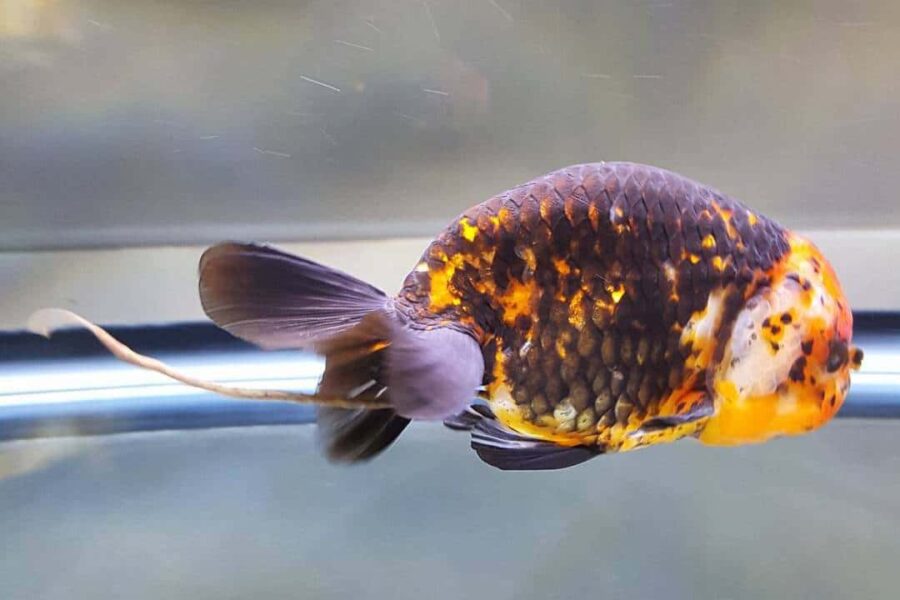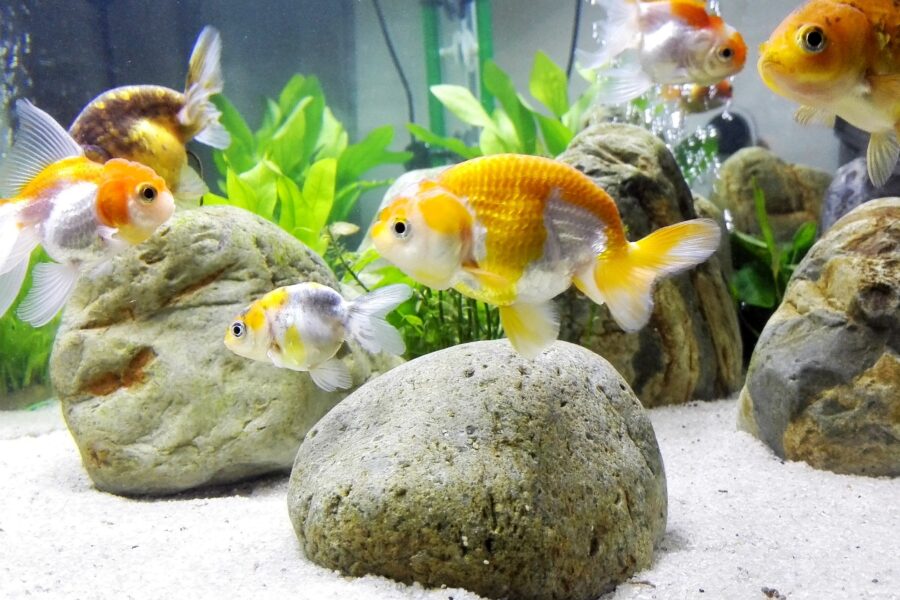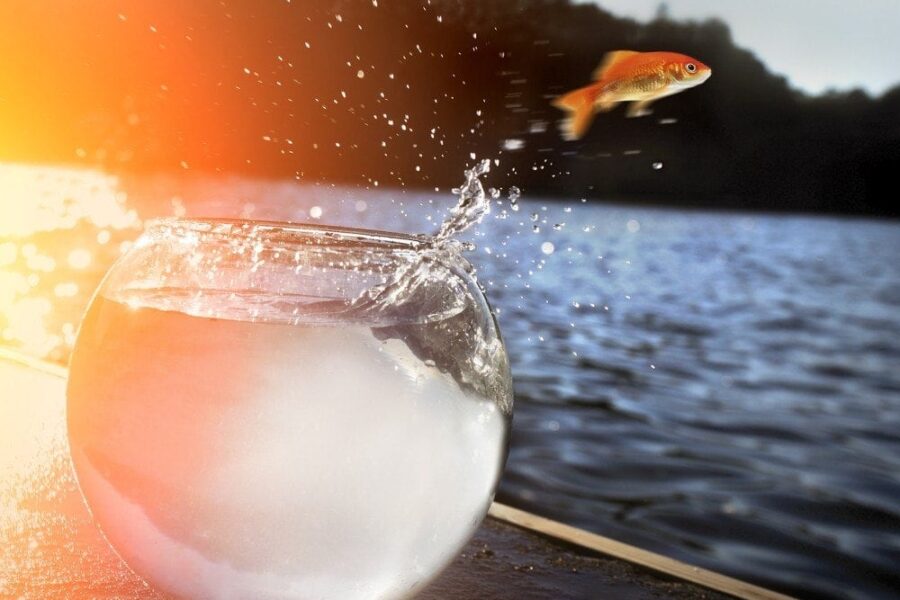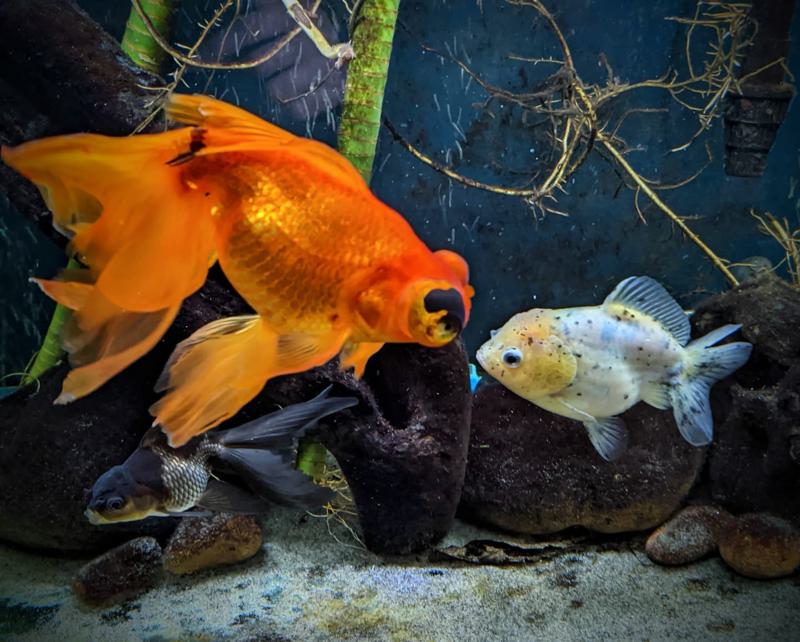
Ammonia Poisoning in Goldfish: it sounds like the title of a mystery novel, but it’s far more fishy than that! In the murky waters of your beloved goldfish tank lurks a silent killer – ammonia. This treacherous toxin rises from the depths, spawned by the very waste your golden pals create. If left unchecked, this nasty intruder can wreak havoc on your fishy friends, causing symptoms ranging from sluggishness to, dare we say it, the big sleep with the fishes.
But fear not! We’re here to arm you with the knowledge to fight back, defeat the dreaded ammonia poisoning, and keep your goldfish swimming happily ever after. So put on your detective hat and get ready to solve the case of the fishy foe. Let’s dive in!
The Straight Poop on Goldfish Poop
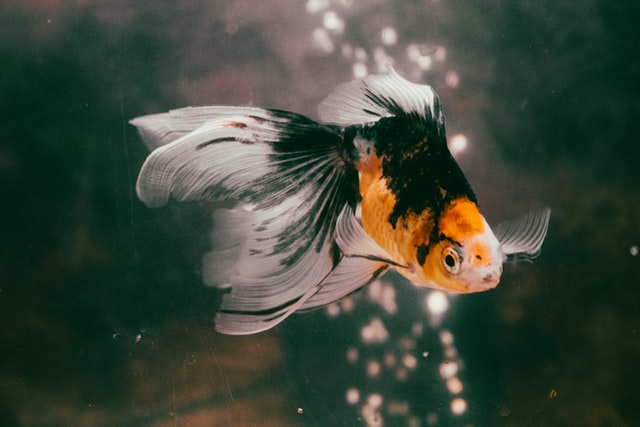
Why Goldfish Produce a Lot of Waste
Goldfish, those shiny little dudes, surprisingly poop a lot more than their body weight suggests. They lack stomachs, you see (yes, seriously), meaning their digestive process is a non-stop conveyor belt of food in and waste out. Imagine that next time you’re munching on your breakfast!
How Excessive Waste Can Lead to Ammonia Buildup
With all the poop floating around, your goldfish’s tank becomes the perfect playground for ammonia. This nasty chemical forms as a result of decomposing waste, uneaten food, and even the charming wet breaths (gills exhale) from your fish! Too much of it, and your beautiful goldfish could be swimming in danger.
Just as we don’t fancy living in a room full of our waste, neither do goldfish (they’re quite sophisticated, really). Now that we’ve tackled the poop situation, let’s move onto the next suspect in our investigation – the notorious, invisible invader: Ammonia. Hold your little goldfish close, folks, this is where things get heavy.
Spotting the Nasty Invader: Ammonia
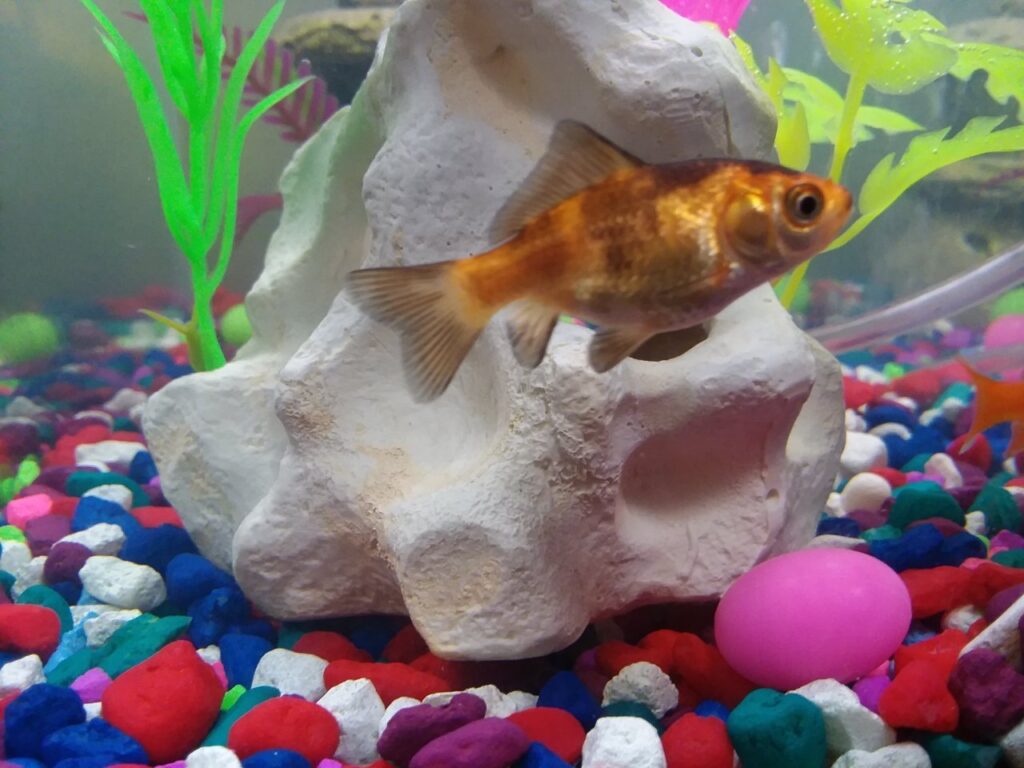
Alright fish parents, it’s time for some serious talk. We’ve got to face the harsh truth and confront the sneaky culprit in our pretty little water-scapes – ammonia.
Where Does Ammonia in the Tank Come From
So, where does this nasty little invader, aka ammonia, sneak in from? Well, it’s no external foe. It’s coming from inside your tank, a result of the biological processes going on there. Bet you didn’t see that coming, huh? The waste your goldfish produces (and to think that adorable wiggling could lead to such horror), uneaten food, and plant matter all break down into ammonia. And yep, just like that, you’ve got an invisible bad guy.
Here’s a nifty nugget for our fellow trivia buffs – even your goldfish’s gills excrete ammonia. Okay, let’s leave that factoid here and motor on, shall we?
Reasons Why Ammonia Levels Might Increase in the Tank
Now comes the million-dollar question: why would these ammonia levels go to the roof? Remember, a busy tank equals more waste, so overstocking is a major no-no. Overfeeding is another biggie. Unconsumed food swiftly decomposes, releasing (you’ve got it) fish-tanking ammonia.
Stressful conditions also urge your goldfish to excrete more ammonia (even fish can’t handle stress well, it appears). We’re talking poor water quality, temperature inconsistencies, or even bacterial attacks. Oh, and let’s not forget a faulty or outdated filtration system – they can be as effective as a chocolate teapot when it comes to purifying your tank water.
Alright, that was intense. But worry not, goldfish guardians! Let’s swim over to the next section, where we’ll deal with the repercussions of our invisible enemy, ammonia. Brace yourself; it’s going to get real!
Effects of Ammonia Poisoning in Goldfish
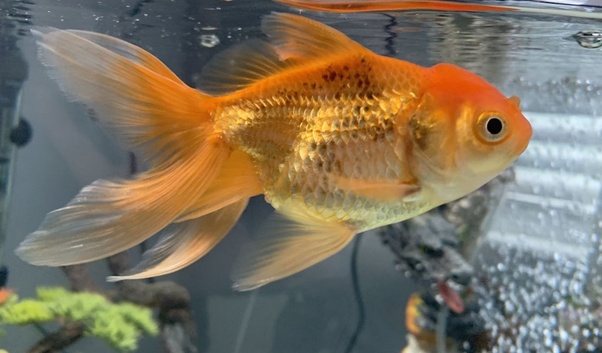
Think life’s tough for you? Imagine you’re a goldfish swimming around in a sea of your own pee. Every splash seems to push you closer to a grave dance.
Symptoms of Ammonia Poisoning in Goldfish
How do you know when L’il Fin’s ailing from ammonia ripping through his goldfish veins? It ain’t like he can tap your shoulder and notify you. The most common symptoms include lethargy, loss of appetite, redness, and rapid gill movement. Nah, they’re not trying to beatbox underwater. Their gills might just be on fire from ammonia.
Don’t forget – gulping at water’s surface, erratic swimming and lying at the bottom of their tank. Hey, talk about a moment of hard truth at the bottom!
How Ammonia Poisoning Could Be Fatal
Ammonia: goldfish owner’s ultimate dread monster. Too real, no jesting, it’s the cross a goldfish must bear. It affects the gills, impairs their breathing and weakens the immune system of our underwater friends. Too much and it could be end game for our little Nemo.
And the grimmer part? Fatal levels of ammonia can cause the nasty brown blood disease. Blood turns brown because red blood cells start losing their ability to carry oxygen efficiently. Quite a harsh blow, right?
Now that we know these horrifying effects of ammonia, let’s dive into something a little more hopeful. How about arsenals we can pull to keep the deadly ammonia at bay? Stay with me, we are about to demystify how to ensure our gold pal’s life isn’t literally, ‘in the tank.’
Don’t Be a Dope, Test the Water!

There, you heard it pop right out of the fishbowl – test the water! As mom always said, “An ounce of prevention is worth a pound of cure.”
The ABC and D of ammonia testing
Regular ammonia tests are like oil checks for your car. They’re essential to prevent your whole engine, or in this case, your fishy friends, from conking out. Conduct these tests routinely, especially if your fish start acting differently. Ammonia can accumulate quickly. Regular testing helps catch an increase before it turns into a toxic time bomb!
For the average Joe, an ammonia spike is something you want to catch early. Just imagine keeping your goldfish from turning into distressed little Rambos warding off chemical attacks.
Mastering the Ammonia Test Kit Tango
Using an ammonia test kit is like flying a kite. At first glance, it might give you anxiety sweats, but once you know the steps, it’s as breezy as a Sunday morning. Let’s break it down:
- Scoop out water from the tank – that’s your kite.
- Add test chemicals – the wind.
- Wait for the color to change – let that kite soar!
Compare the resultant color with the guide provided in the kit. If it’s as green as Hulk in a temper tantrum, it’s time to take action.
After all this talk about ammonia, you might feel like you’ve been smacked with a science textbook. Don’t worry, we’ll move into easier waters soon. Coming up – we’ve got the scoop on treating and preventing ammonia poisoning in your globular pets. Saving your goldfish from a toxic shootout and turning your tank into a happy water wonderland is beyond possible!
Treating Ammonia Poisoning in Goldfish

Ever seen “Finding Nemo,” where little finned heroes tackled life under waves? Yeah, your goldfish needs just as much bravery facing off with mighty Ammonia. Fear not, we’re sending in some reinforcement!
Immediate Steps to Tackle Those Nasty Ammonia Fiends
BAM! Nemo’s in distress, spotted signs of ammonia poisoning? What’s next? Simple! First off, don’t panic. We’ve seen Dory manage that, so can you! Start with a massive water change – around 50-75% should do the trick. No, this isn’t you being lazy avoiding that weekly 10-15% clean up. This is the aquatic equivalent of an emergency room. Second, use a water conditioner specially designed to neutralize ammonia. Within hours you’ll have a safer environment for your finned buddy.
Push-back against ammonia needs hard and swift moves! But what about long-term? How can Nemo keep safe from such sneak-attacks in future?
Long-Term Solutions: Maintain Low Ammonia Levels
Goldie wants to swim, not fight toxic battles daily. Long-term peace comes from consistent efforts. That starts with regular water changes. Think of it as Nemo’s version of weekly spa day, keeping things fresh, clear and soothing. 20-25% of water changed every week should do it. Closely monitor your tank’s ammonia levels with a test kit. Another step? A well-functioning, powerful filter that can handle your tank size will keep ammonia in check.
Remember, long-term solutions require investment. Time, effort, and some cash. However, it safeguards Goldie from any ammonia havoc. Embrace these, and postpone reservations to fishy ICU. Next, let’s delve into how we can prevent this situation from even happening at all. Because, as they say, “prevention is better than cure!”
Preventing Ammonia Poisoning in Goldfish
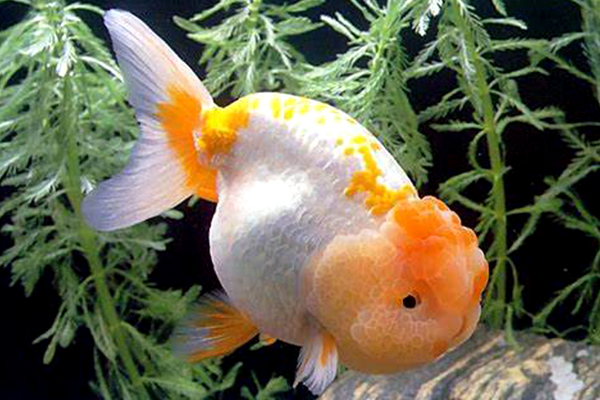
Let’s shift gear now, shall we? We’ve talked enough about the doom and gloom of ammonia poisoning. Time to look at how we can avoid it altogether!
Cut the Crap: Reducing Waste in the Tank
Step one in preventing ammonia mishaps is reducing waste. Hey, even a goldfish needs a clean toilet, right? The trick: Don’t overfeed. Goldfish are opportunistic feeders, often eating more than they need. Remember, whatever goes in, must come out! Deliberate on their diets. Introduce enough food just for them to consume in two minutes.
Water Changes: Not Just for the Weather
Next up, regular water changes. Imagine being stuck inside a room filled with your own exhaust – Not fun, right? The same applies to your goldfish. Weekly water changes of around 25-50% can help remove some of that accumulated waste and keep ammonia at bay. It’s like giving their home a weekly spruce-up!
Size Matters: Choosing the Right Tank and Filtration
Lastly, let’s talk about real estate – tank size and filtration. It’s a myth that goldfish adapt their size to the tank. They need space, just like how we’d hate being stuffed into a phone booth. A larger tank dilutes waste and reduces the concentration of ammonia. Now, for filtration, you’ll need both mechanical and biological. Mechanical filters catch solid waste, while biological filters handle, well, the biological stuff (like converting toxic ammonia into safer substances).
Wrap Up
In essence, taking care of goldfish becomes a science, balancing the scales of food input and waste output. An overload of waste leads to an unhealthy rise in ammonia levels, courtesy of our finned friends. Arm yourself with the knowledge to identify ammonia poisoning symptoms, as ignoring these could result in utter tragedy.
Regular water testing will keep you ahead of potential problems, don’t underestimate this. Treating ammonia issues is crucial, but why firefight when you can prevent? So, adjust your lens to focus on the big picture – reducing waste, regular water changes, and investing in a good tank and filter system are ultimately key in preventing a goldfish catastrophe.
Frequently Asked Questions (FAQ)
Question: Why do goldfish produce a lot of waste?
Answer: Goldfish are known for being heavy feeders which means that they digest a lot of food and produce a significant amount of waste full of ammonia.
Question: Where does the ammonia in the tank come from?
Answer: Ammonia is a byproduct of fish waste, uneaten food, and dead plants or animals in the tank.
Question: What are the symptoms of ammonia poisoning in goldfish?
Answer: Signs include gasping at the water’s surface, lethargy, red or inflamed gills, and loss of balance.
Question: How often should I test the water for ammonia?
Answer: It’s a good idea to test your tank water for ammonia weekly, or when behavioral symptoms are observed in your goldfish.
Question: What steps should be taken when ammonia poisoning is suspected?
Answer: Begin by isolating the affected goldfish, performing a water test, and changing 50% of the tank water. You should also clean the tank thoroughly to ensure ammonia levels do not increase.
Question: How can I prevent ammonia buildup in my goldfish tank?
Answer: Regular water changes, appropriate feeding amounts, good tank hygiene, adequate tank size and an efficient filtration system can help prevent ammonia buildup.
Question: What is the importance of the right tank and filtration system?
Answer: The right tank and filtration system can help manage the ammonia levels in the water, reducing the risk of poisoning. It’s essential to ensure the system is designed to cope with the amount of waste your fish produce.

